HSB-SPAM: An Efficient Image Filtering Detection Technique
Abstract
1. Introduction
- The proposed scheme can reduce the bit depth to attain more relevant information in difference arrays. Higher significant bit-planes are considered for strong statistical analysis.
- Various derivatives such as pixel difference, separate pixel difference, and the Laplacian operator are considered for a robust feature vector that can help in collecting additional information so that accuracy can be further enhanced. Further, the co-occurrence statistics is extracted from derivatives using the Markov chain.
- Experimental results are compared with some of the popular methods such as GLF, GDCTF, PERB and SPAM to evaluate the performance of the proposed scheme. For the exhaustive analysis, the experimental results are shown for median filtered, mean filtered and Gaussian filtered images.
- The experimental analysis shows that the proposed method has better performance than existing methods in most of the scenarios. There is a significant improvement of more than 2% in detection accuracy for the case of 3 × 3 size filter on the low-resolution images and highly compressed images.
2. Related Work
3. The Proposed Method
3.1. Higher Significant Bit-Plane Analysis
3.2. Pixel Difference Arrays and Markov Chain
4. Experimental Results
4.1. Results for Non-Filtered and Filtered Images
| IMAGE SIZE | JPEG COM. | ORI vs. MF3 | ORI vs. MF5 | ||||||||
|---|---|---|---|---|---|---|---|---|---|---|---|
| GLF | GDCTF | PERB | SPAM | HSB-SPAM | GLF | GDCTF | PERB | SPAM | HSB-SPAM | ||
| 128 × 128 | No | 0.38 | 12.67 | 6.32 | 0.00 | 0.38 | 0.76 | 8.04 | 5.28 | 0.00 | 0.83 |
| Q = 70 | 6.56 | 16.08 | 9.10 | 7.08 | 3.40 | 2.74 | 9.92 | 6.53 | 3.02 | 2.33 | |
| Q = 50 | 9.51 | 17.26 | 10.00 | 11.91 | 4.79 | 3.51 | 10.30 | 6.91 | 4.90 | 3.65 | |
| Q = 30 | 12.08 | 19.41 | 11.46 | 15.80 | 7.19 | 4.79 | 10.81 | 7.60 | 7.53 | 4.38 | |
| 64 × 64 | No | 0.59 | 17.49 | 9.41 | 0.17 | 0.83 | 1.35 | 10.24 | 7.99 | 0.17 | 1.39 |
| Q = 70 | 9.41 | 20.90 | 14.48 | 12.05 | 6.42 | 4.93 | 11.87 | 10.07 | 6.67 | 4.59 | |
| Q = 50 | 13.30 | 21.97 | 14.79 | 17.19 | 8.68 | 6.39 | 13.29 | 10.63 | 10.24 | 5.94 | |
| Q = 30 | 15.83 | 23.47 | 16.22 | 21.84 | 11.49 | 7.83 | 14.72 | 11.04 | 12.15 | 6.98 | |
| 32 × 32 | No | 1.01 | 23.68 | 13.68 | 0.28 | 1.35 | 1.77 | 18.53 | 11.01 | 0.42 | 2.12 |
| Q = 70 | 14.93 | 25.66 | 19.97 | 19.51 | 10.73 | 7.92 | 20.13 | 13.75 | 11.46 | 8.40 | |
| Q = 50 | 18.54 | 27.91 | 22.26 | 23.96 | 15.73 | 10.12 | 21.21 | 14.58 | 13.09 | 9.86 | |
| Q = 30 | 21.98 | 29.09 | 23.65 | 28.58 | 19.41 | 11.91 | 22.11 | 15.45 | 17.67 | 11.67 | |
| IMAGE SIZE | JPEG COM. | ORI vs. AVG3 | ORI vs. AVG5 | ||||||||
|---|---|---|---|---|---|---|---|---|---|---|---|
| GLF | GDCTF | PERB | SPAM | HSB-SPAM | GLF | GDCTF | PERB | SPAM | HSB-SPAM | ||
| 128 × 128 | No | 0.63 | 5.11 | 5.63 | 0.45 | 0.56 | 0.56 | 2.36 | 3.40 | 0.66 | 0.76 |
| Q = 70 | 1.46 | 4.35 | 6.11 | 2.92 | 0.90 | 1.15 | 3.99 | 3.85 | 1.39 | 0.76 | |
| Q = 50 | 1.46 | 5.21 | 6.08 | 4.76 | 1.01 | 1.60 | 4.65 | 3.92 | 2.40 | 1.15 | |
| Q = 30 | 1.81 | 6.22 | 6.88 | 6.39 | 0.97 | 1.67 | 4.97 | 3.65 | 2.60 | 1.56 | |
| 64 × 64 | No | 1.39 | 8.53 | 8.75 | 1.91 | 1.49 | 1.32 | 6.01 | 5.73 | 1.53 | 0.69 |
| Q = 70 | 3.72 | 9.19 | 10.07 | 5.73 | 3.33 | 2.92 | 7.33 | 7.57 | 3.92 | 1.91 | |
| Q = 50 | 4.93 | 10.31 | 10.49 | 7.99 | 4.41 | 3.19 | 8.02 | 7.67 | 5.49 | 2.19 | |
| Q = 30 | 6.39 | 12.63 | 11.11 | 10.14 | 5.73 | 3.33 | 8.65 | 7.40 | 5.42 | 2.78 | |
| 32 × 32 | No | 1.53 | 15.69 | 12.26 | 2.71 | 2.26 | 2.19 | 14.24 | 9.03 | 2.64 | 1.25 |
| Q = 70 | 6.15 | 18.53 | 14.62 | 9.79 | 5.18 | 4.76 | 15.73 | 11.22 | 7.12 | 4.10 | |
| Q = 50 | 8.85 | 19.36 | 15.66 | 13.26 | 7.79 | 5.90 | 16.60 | 11.28 | 8.51 | 4.79 | |
| Q = 30 | 11.18 | 20.03 | 15.97 | 15.69 | 9.83 | 6.18 | 18.06 | 10.73 | 9.83 | 5.59 | |
| IMAGE SIZE | JPEG COM. | ORI vs. GAU3 | ORI vs. GAU5 | ||||||||
|---|---|---|---|---|---|---|---|---|---|---|---|
| GLF | GDCTF | PERB | SPAM | HSB-SPAM | GLF | GDCTF | PERB | SPAM | HSB-SPAM | ||
| 128 × 128 | No | 0.73 | 5.99 | 0.45 | 0.35 | 0.63 | 1.01 | 3.65 | 3.19 | 0.45 | 0.87 |
| Q = 70 | 2.19 | 8.28 | 1.39 | 3.47 | 1.63 | 2.33 | 5.01 | 4.44 | 1.98 | 1.91 | |
| Q = 50 | 2.74 | 9.39 | 1.46 | 4.55 | 2.19 | 2.67 | 6.16 | 4.72 | 3.16 | 2.26 | |
| Q = 30 | 3.13 | 10.30 | 1.56 | 5.45 | 2.47 | 3.09 | 6.93 | 5.03 | 3.82 | 2.50 | |
| 64 × 64 | No | 1.49 | 9.43 | 7.60 | 0.69 | 1.56 | 1.25 | 5.99 | 5.80 | 0.73 | 1.18 |
| Q = 70 | 4.48 | 11.24 | 10.38 | 7.05 | 3.62 | 3.23 | 6.79 | 7.78 | 3.82 | 3.13 | |
| Q = 50 | 6.53 | 13.36 | 11.04 | 8.99 | 5.66 | 4.44 | 7.83 | 8.58 | 5.90 | 3.89 | |
| Q = 30 | 8.51 | 15.58 | 12.12 | 12.22 | 7.19 | 5.24 | 9.68 | 9.24 | 7.33 | 4.93 | |
| 32 × 32 | No | 1.74 | 16.83 | 11.42 | 1.84 | 2.15 | 1.42 | 12.74 | 7.99 | 1.15 | 1.67 |
| Q = 70 | 7.81 | 17.81 | 14.93 | 11.91 | 7.47 | 5.07 | 13.34 | 11.74 | 7.81 | 4.90 | |
| Q = 50 | 10.59 | 19.79 | 16.18 | 14.79 | 9.66 | 7.40 | 16.14 | 12.78 | 9.65 | 6.91 | |
| Q = 30 | 13.72 | 22.91 | 17.53 | 19.72 | 11.95 | 9.79 | 18.40 | 13.72 | 13.23 | 8.96 | |
| Technique | NC | Q = 70 | Q = 50 | Q = 30 | Technique | NC | Q = 70 | Q = 50 | Q = 30 | ||
|---|---|---|---|---|---|---|---|---|---|---|---|
| ORI vs. MF3 | GLF | 0.63 | 10.35 | 13.43 | 17.26 | ORI vs. MF5 | GLF | 1.39 | 4.93 | 6.71 | 7.99 |
| GDCTF | 19.24 | 22.78 | 24.17 | 23.93 | GDCTF | 11.06 | 12.11 | 13.56 | 15.16 | ||
| PERB | 9.60 | 15.49 | 16.27 | 17.84 | PERB | 8.39 | 10.07 | 11.05 | 11.59 | ||
| SPAM | 0.19 | 13.01 | 17.36 | 22.71 | SPAM | 1.19 | 7.13 | 11.06 | 12.52 | ||
| HSB-SPAM | 0.88 | 6.49 | 9.46 | 11.61 | HSB-SPAM | 0.47 | 4.64 | 6.53 | 7.61 | ||
| ORI vs. AVG3 | GLF | 1.43 | 3.90 | 5.03 | 6.96 | ORI vs. AVG5 | GLF | 1.45 | 2.92 | 3.51 | 3.63 |
| GDCTF | 8.87 | 9.19 | 10.92 | 13.01 | GDCTF | 6.55 | 7.47 | 8.34 | 9.51 | ||
| PERB | 9.10 | 10.88 | 11.01 | 12.00 | PERB | 5.84 | 8.02 | 8.44 | 7.99 | ||
| SPAM | 2.04 | 6.07 | 8.39 | 10.14 | SPAM | 1.59 | 4.20 | 5.49 | 5.58 | ||
| HSB-SPAM | 1.57 | 3.37 | 4.76 | 5.90 | HSB-SPAM | 0.76 | 1.97 | 2.30 | 3.00 | ||
| ORI vs. GAU3 | GLF | 1.64 | 4.75 | 6.92 | 8.93 | ORI vs. GAU5 | GLF | 1.33 | 3.33 | 4.53 | 5.61 |
| GDCTF | 9.43 | 11.69 | 14.30 | 16.36 | GDCTF | 6.41 | 7.27 | 8.46 | 9.87 | ||
| PERB | 7.83 | 11.11 | 11.26 | 12.85 | PERB | 6.20 | 8.17 | 9.09 | 9.61 | ||
| SPAM | 0.71 | 7.12 | 9.71 | 13.32 | SPAM | 0.79 | 4.20 | 6.32 | 7.47 | ||
| HSB-SPAM | 1.56 | 3.62 | 5.66 | 7.62 | HSB-SPAM | 1.18 | 3.44 | 4.12 | 4.98 |
4.2. Results for Complex Scenarios
| METHODS | MF3 | MF3 | MF3 | MF3 | MF3 | MF5 | MF5 | MF5 | MF5 | AVG3 | AVG3 | AVG5 | AVG5 | AVG3 | GAU3 |
|---|---|---|---|---|---|---|---|---|---|---|---|---|---|---|---|
| MF5 | AVG3 | AVG5 | GAU3 | GAU5 | AVG3 | AVG5 | GAU3 | GAU5 | GAU3 | GAU5 | GAU3 | GAU5 | AVG5 | GAU5 | |
| Image Size 64 × 64 Uncompressed | |||||||||||||||
| GLF | 94.55 | 99.27 | 98.00 | 99.17 | 99.27 | 98.96 | 98.19 | 98.99 | 99.10 | 95.00 | 94.00 | 97.99 | 97.48 | 96.00 | 84.00 |
| GDCTF | 67.00 | 76.00 | 86.00 | 74.00 | 81.00 | 70.00 | 80.00 | 70.00 | 75.00 | 70.00 | 70.00 | 77.00 | 70.00 | 75.00 | 67.00 |
| PERB | 83.54 | 81.08 | 88.33 | 79.55 | 81.11 | 85.49 | 76.70 | 88.02 | 87.19 | 61.53 | 64.27 | 86.98 | 82.74 | 82.85 | 66.56 |
| SPAM | 98.96 | 99.26 | 99.48 | 99.69 | 99.69 | 99.72 | 99.65 | 99.72 | 99.76 | 87.88 | 92.53 | 96.77 | 95.80 | 87.15 | 84.03 |
| HSB-SPAM | 96.32 | 99.82 | 99.65 | 99.41 | 99.48 | 99.34 | 98.30 | 99.41 | 99.55 | 96.90 | 96.00 | 98.33 | 97.99 | 97.78 | 86.00 |
| Image Size 64 × 64 JPEG Q = 70 | |||||||||||||||
| GLF | 89.93 | 93.58 | 96.76 | 86.67 | 92.78 | 95.38 | 93.85 | 93.72 | 94.97 | 82.57 | 69.55 | 97.35 | 96.15 | 96.56 | 76.70 |
| GDCTF | 68.00 | 76.00 | 87.00 | 70.00 | 80.00 | 66.00 | 79.00 | 80.00 | 69.00 | 57.00 | 58.00 | 91.00 | 67.00 | 73.00 | 62.00 |
| PERB | 81.91 | 74.86 | 88.58 | 69.20 | 81.22 | 85.31 | 80.87 | 87.47 | 88.68 | 58.82 | 56.81 | 87.33 | 81.46 | 82.88 | 67.47 |
| SPAM | 83.40 | 87.05 | 93.75 | 76.91 | 90.97 | 91.81 | 90.52 | 91.18 | 92.53 | 59.65 | 61.11 | 95.63 | 84.20 | 86.22 | 74.27 |
| HSB-SPAM | 91.99 | 96.38 | 98.74 | 92.60 | 96.52 | 98.29 | 96.87 | 95.69 | 97.74 | 82.81 | 71.93 | 99.13 | 98.53 | 98.56 | 78.95 |
| Image Size 64 × 64 JPEG Q = 50 | |||||||||||||||
| GLF | 87.57 | 90.49 | 97.71 | 87.74 | 90.97 | 93.19 | 93.30 | 92.85 | 92.64 | 75.83 | 62.33 | 96.25 | 95.31 | 96.53 | 74.31 |
| GDCTF | 67.00 | 74.00 | 87.00 | 70.00 | 79.00 | 64.00 | 77.00 | 63.00 | 66.00 | 60.00 | 59.00 | 79.00 | 69.00 | 73.00 | 63.00 |
| PERB | 81.39 | 75.87 | 89.41 | 68.47 | 82.67 | 84.90 | 79.51 | 86.15 | 86.42 | 60.03 | 55.63 | 87.60 | 81.08 | 83.02 | 67.57 |
| SPAM | 79.65 | 83.44 | 92.36 | 78.33 | 87.92 | 87.29 | 88.16 | 86.98 | 87.12 | 59.34 | 57.12 | 89.20 | 83.16 | 84.13 | 70.31 |
| HSB-SPAM | 89.68 | 95.06 | 98.43 | 92.18 | 95.65 | 96.10 | 95.76 | 95.06 | 95.65 | 78.00 | 64.89 | 98.50 | 97.34 | 98.00 | 76.63 |
| Image Size 64 × 64 JPEG Q = 30 | |||||||||||||||
| GLF | 86.42 | 87.74 | 97.15 | 80.73 | 89.10 | 88.75 | 92.53 | 87.71 | 87.33 | 71.77 | 58.99 | 96.15 | 94.24 | 95.38 | 71.94 |
| GDCTF | 67.00 | 71.00 | 87.00 | 65.00 | 75.00 | 61.00 | 76.00 | 61.00 | 64.00 | 60.00 | 52.99 | 80.00 | 71.00 | 75.00 | 64.00 |
| PERB | 81.04 | 75.38 | 89.31 | 67.53 | 82.05 | 81.11 | 79.83 | 82.88 | 82.36 | 59.31 | 55.07 | 87.60 | 81.18 | 82.85 | 69.65 |
| SPAM | 76.77 | 79.34 | 92.29 | 69.69 | 84.27 | 79.51 | 85.31 | 80.17 | 79.34 | 54.17 | 54.51 | 88.82 | 81.91 | 84.03 | 68.37 |
| HSB-SPAM | 88.35 | 92.11 | 97.88 | 88.05 | 93.64 | 92.56 | 94.85 | 91.80 | 91.97 | 71.42 | 61.24 | 97.43 | 96.13 | 96.07 | 75.03 |
| JPEG COM. | Training: ORI-MF3 & Testing: ORI-MF5 | Training: ORI-MF5 & Testing: ORI-MF3 | ||||||||
|---|---|---|---|---|---|---|---|---|---|---|
| GLF | GDCTF | PERB | SPAM | HSB-SPAM | GLF | GDCTF | PERB | SPAM | HSB-SPAM | |
| NC | 0.97 | 17.49 | 10.76 | 1.08 | 0.07 | 15.84 | 22.87 | 20.59 | 0.11 | 1.38 |
| Q = 70 | 9.68 | 21.00 | 14.24 | 8.33 | 5.83 | 34.68 | 24.81 | 26.05 | 25.69 | 19.02 |
| Q = 50 | 12.37 | 21.94 | 14.84 | 11.73 | 7.92 | 35.46 | 27.80 | 28.21 | 27.22 | 26.42 |
| Q = 30 | 13.64 | 23.36 | 15.96 | 12.89 | 10.20 | 34.79 | 30.04 | 29.37 | 30.23 | 28.55 |
| Training: ORI-AVG3 & Testing: ORI-AVG5 | Training: ORI-AVG5 & Testing: ORI-AVG3 | |||||||||
| GLF | GDCTF | PERB | SPAM | HSB-SPAM | GLF | GDCTF | PERB | SPAM | HSB-SPAM | |
| NC | 11.51 | 8.41 | 8.26 | 1.27 | 3.14 | 18.54 | 15.88 | 16.89 | 16.48 | 17.00 |
| Q = 70 | 19.02 | 10.16 | 9.30 | 5.31 | 4.07 | 19.99 | 19.21 | 18.87 | 29.93 | 16.93 |
| Q = 50 | 11.29 | 11.10 | 9.90 | 5.49 | 5.08 | 20.18 | 20.37 | 20.59 | 32.10 | 18.31 |
| Q = 30 | 8.63 | 12.71 | 10.01 | 6.32 | 4.97 | 20.18 | 21.00 | 21.79 | 36.25 | 21.11 |
| Training: ORI-GAU3 & Testing: ORI-GAU5 | Training: ORI-GAU5 & Testing: ORI-GAU3 | |||||||||
| GLF | GDCTF | PERB | SPAM | HSB-SPAM | GLF | GDCTF | PERB | SPAM | HSB-SPAM | |
| NC | 1.08 | 9.12 | 7.62 | 0.89 | 0.71 | 1.61 | 14.20 | 9.94 | 1.42 | 1.27 |
| Q = 70 | 3.59 | 11.62 | 9.94 | 3.96 | 3.33 | 6.09 | 16.59 | 11.40 | 8.26 | 6.24 |
| Q = 50 | 5.23 | 13.23 | 10.05 | 5.57 | 3.92 | 7.92 | 18.12 | 11.70 | 10.13 | 7.88 |
| Q = 30 | 6.13 | 15.10 | 11.81 | 7.21 | 4.56 | 10.46 | 21.00 | 12.97 | 13.15 | 8.48 |
5. Conclusions
Author Contributions
Funding
Institutional Review Board Statement
Informed Consent Statement
Data Availability Statement
Acknowledgments
Conflicts of Interest
References
- Matern, F.; Riess, C.; Stamminger, M. Gradient-Based Illumination Description for Image Forgery Detection. IEEE Trans. Inf. Forensics Secur. 2020, 15, 1303–1317. [Google Scholar] [CrossRef]
- Moghaddasi, Z.; Jalab, H.A.; Noor, R.M. Image splicing forgery detection based on low-dimensional singular value decomposition of discrete cosine transform coefficients. Neural Comput. Appl. 2019, 31, 7867–7877. [Google Scholar] [CrossRef]
- Marra, F.; Gragnaniello, D.; Verdoliva, L.; Poggi, G. A Full-Image Full-Resolution End-to-End-Trainable CNN Framework for Image Forgery Detection. IEEE Access 2020, 8, 133488–133502. [Google Scholar] [CrossRef]
- Almabdy, S.; Elrefaei, L. Deep convolutional neural network-based approaches for face recognition. Appl. Sci. 2019, 9, 4397. [Google Scholar] [CrossRef]
- Liu, L.; Ouyang, W.; Wang, X.; Fieguth, P.; Chen, J.; Liu, X.; Pietikäinen, M. Deep Learning for Generic Object Detection: A Survey. Int. J. Comput. Vis. 2020, 128, 261–318. [Google Scholar] [CrossRef]
- Paszkiel, S. Using Neural Networks for Classification of the Changes in the EEG Signal Based on Facial Expressions. In Studies in Computational Intelligence; Springer: Cham, Switzerland, 2020; Volume 852, pp. 41–69. [Google Scholar]
- Marra, F.; Poggi, G.; Roli, F.; Sansone, C.; Verdoliva, L. Counter-forensics in machine learning based forgery detection. In Proceedings of the Media Watermarking, Security, and Forensics, San Francisco, CA, USA, 9–11 February2015; Alattar, A.M., Memon, N.D., Heitzenrater, C.D., Eds.; SPIE: Bellingham, WA, USA, 2015; Volume 9409, p. 94090L. [Google Scholar]
- Kim, D.; Jang, H.-U.; Mun, S.-M.; Choi, S.; Lee, H.-K. Median Filtered Image Restoration and Anti-Forensics Using Adversarial Networks. IEEE Signal Process. Lett. 2018, 25, 278–282. [Google Scholar] [CrossRef]
- Gragnaniello, D.; Marra, F.; Poggi, G.; Verdoliva, L. Analysis of Adversarial Attacks against CNN-based Image Forgery Detectors. In Proceedings of the 2018 26th European Signal Processing Conference (EUSIPCO), Rome, Italy, 3–7 September 2018; IEEE: New York, NY, USA, 2018; Volume 2018, pp. 967–971. [Google Scholar]
- Kirchner, M.; Fridrich, J. On detection of median filtering in digital images. In Proceedings of the Media Forensics and Security II, San Jose, CA, USA, 27 January 2010; Memon, N.D., Dittmann, J., Alattar, A.M., Delp, E.J., III, Eds.; SPIE: Bellingham, WA, USA, 2010; Volume 7541, p. 754110. [Google Scholar]
- Pevny, T.; Bas, P.; Fridrich, J. Steganalysis by Subtractive Pixel Adjacency Matrix. IEEE Trans. Inf. Forensics Secur. 2010, 5, 215–224. [Google Scholar] [CrossRef]
- Chen, C.; Ni, J.; Huang, J. Blind Detection of Median Filtering in Digital Images: A Difference Domain Based Approach. IEEE Trans. Image Process. 2013, 22, 4699–4710. [Google Scholar] [CrossRef]
- Cao, G.; Zhao, Y.; Ni, R.; Yu, L.; Tian, H. Forensic detection of median filtering in digital images. In Proceedings of the 2010 IEEE International Conference on Multimedia and Expo, Singapore, 19–23 July 2010; pp. 89–94. [Google Scholar] [CrossRef]
- Agarwal, S.; Chand, S.; Skarbnik, N. SPAM revisited for median filtering detection using higher-order difference. Secur. Commun. Netw. 2016, 9, 4089–4102. [Google Scholar] [CrossRef]
- Niu, Y.; Zhao, Y.; Ni, R.R. Robust median filtering detection based on local difference descriptor. Signal Process. Image Commun. 2017, 53, 65–72. [Google Scholar] [CrossRef]
- Kang, X.; Stamm, M.C.; Peng, A.; Liu, K.J.R. Robust median filtering forensics using an autoregressive model. IEEE Trans. Inf. Forensics Secur. 2013, 8, 1456–1468. [Google Scholar] [CrossRef]
- Ferreira, A.; Rocha, A. A Multiscale and Multi-Perturbation Blind Forensic Technique for Median Detecting. In Iberoamerican Congress on Pattern Recognition; Lecture Notes in Computer Science; Springer: Cham, Switzerland, 2014; Volume 8827, pp. 302–310. ISBN 9783319125671. [Google Scholar]
- Chen, J.; Kang, X.; Liu, Y.; Wang, Z.J. Median Filtering Forensics Based on Convolutional Neural Networks. IEEE Signal Process. Lett. 2015, 22, 1849–1853. [Google Scholar] [CrossRef]
- Hwang, J.J.; Rhee, K.H. Gaussian filtering detection based on features of residuals in image forensics. In Proceedings of the 2016 IEEE RIVF International Conference on Computing & Communication Technologies, Research, Innovation, and Vision for the Future (RIVF), Hanoi, Vietnam, 7–9 November 2016; IEEE: New York, NY, USA, 2016; pp. 153–157. [Google Scholar]
- Liu, A.; Zhao, Z.; Zhang, C.; Su, Y. Median filtering forensics in digital images based on frequency-domain features. Multimed. Tools Appl. 2017, 76, 22119–22132. [Google Scholar] [CrossRef]
- Yang, J.; Ren, H.; Zhu, G.; Shi, J.H.Y. Detecting median filtering via two-dimensional AR models of multiple filtered residuals. Multimed. Tools Appl. 2017, 77, 7931–7953. [Google Scholar] [CrossRef]
- Tang, H.; Ni, R.; Zhao, Y.; Li, X. Median filtering detection of small-size image based on CNN. J. Vis. Commun. Image Represent. 2018, 51, 162–168. [Google Scholar] [CrossRef]
- Bayar, B.; Stamm, M.C. Constrained Convolutional Neural Networks: A New Approach Towards General Purpose Image Manipulation Detection. IEEE Trans. Inf. Forensics Secur. 2018, 13, 2691–2706. [Google Scholar] [CrossRef]
- Wang, D.; Gao, T. Filtered Image Forensics Based on Frequency Domain Features. In Proceedings of the 2018 IEEE 18th International Conference on Communication Technology (ICCT), Chongqing, China, 8–11 October 2018; IEEE: New York, NY, USA, 2018; Volume 2019, pp. 1208–1212. [Google Scholar]
- Li, W.; Ni, R.; Li, X.; Zhao, Y. Robust median filtering detection based on the difference of frequency residuals. Multimed. Tools Appl. 2019, 78, 8363–8381. [Google Scholar] [CrossRef]
- Peng, A.; Luo, S.; Zeng, H.; Wu, Y. Median filtering forensics using multiple models in residual domain. IEEE Access 2019, 7, 28525–28538. [Google Scholar] [CrossRef]
- Rhee, K.H. Improvement Feature Vector: Autoregressive Model of Median Filter Residual. IEEE Access 2019, 7, 77524–77540. [Google Scholar] [CrossRef]
- Rhee, K.H. Forensic Detection Using Bit-Planes Slicing of Median Filtering Image. IEEE Access 2019, 7, 92586–92597. [Google Scholar] [CrossRef]
- Luo, S.; Peng, A.; Zeng, H.; Kang, X.; Liu, L. Deep Residual Learning Using Data Augmentation for Median Filtering Forensics of Digital Images. IEEE Access 2019, 7, 80614–80621. [Google Scholar] [CrossRef]
- Gupta, A.; Singhal, D. A simplistic global median filtering forensics based on frequency domain analysis of image residuals. ACM Trans. Multimed. Comput. Commun. Appl. 2019, 15, 1–23. [Google Scholar] [CrossRef]
- Peng, A.; Yu, G.; Wu, Y.; Zhang, Q.; Kang, X. A universal image forensics of smoothing filtering. Int. J. Digit. Crime Forensics 2019, 11, 18–28. [Google Scholar] [CrossRef]
- Hwang, J.J.; Rhee, K.H. Gaussian Forensic Detection using Blur Quantity of Forgery Image. In Proceedings of the 2019 International Conference on Green and Human Information Technology (ICGHIT), Kuala Lumpur, Malaysia, 16–18 January 2019; IEEE: New York, NY, USA, 2019; pp. 86–88. [Google Scholar]
- Gao, H.; Gao, T. Detection of median filtering based on ARMA model and pixel-pair histogram feature of difference image. Multimed. Tools Appl. 2020, 79, 12551–12567. [Google Scholar] [CrossRef]
- Gao, H.; Gao, T.; Cheng, R. Robust detection of median filtering based on data-pair histogram feature and local configuration pattern. J. Inf. Secur. Appl. 2020, 53, 102506. [Google Scholar] [CrossRef]
- Zhang, J.; Liao, Y.; Zhu, X.; Wang, H.; Ding, J. A Deep Learning Approach in the Discrete Cosine Transform Domain to Median Filtering Forensics. IEEE Signal Process. Lett. 2020, 27, 276–280. [Google Scholar] [CrossRef]
- Schaefer, G.; Stich, M. UCID: An uncompressed color image database. In Proceedings of the Storage and Retrieval Methods and Applications for Multimedia 2004, San Jose, CA, USA, 20 January 2004; Yeung, M.M., Lienhart, R.W., Li, C.-S., Eds.; SPIE: Bellingham, WA, USA, 2003; Volume 5307, pp. 472–480. [Google Scholar]
- Bas, P.; Furon, T. Break Our Watermarking System, 2nd ed. 2008. Available online: http://bows2.ec-lille.fr/ (accessed on 22 June 2020).
- Content, I.; Conventions, N. Columbia Uncompressed Image Splicing Detection Evaluation Dataset. 2014, pp. 2–5. Available online: https://www.ee.columbia.edu/ln/dvmm/downloads/authsplcuncmp/ (accessed on 18 June 2020).
- Dang-Nguyen, D.T.; Pasquini, C.; Conotter, V.; Boato, G. RAISE—A raw images dataset for digital image forensics. In Proceedings of the 6th ACM Multimedia Systems Conference, MMSys 2015, Portland, OR, USA, 18–20 March 2015; ACM: New York, NY, USA, 2015; pp. 219–224. [Google Scholar]

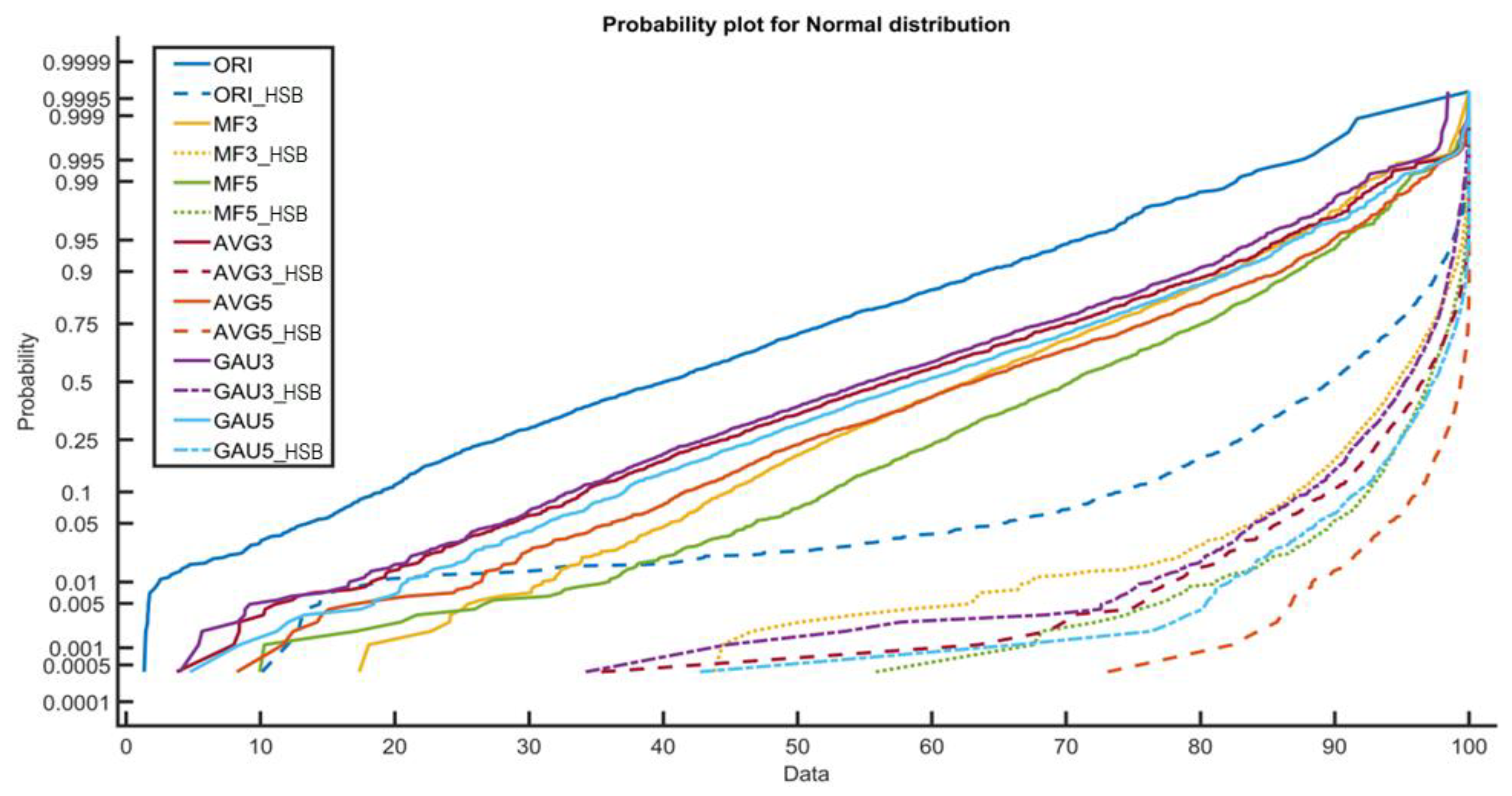

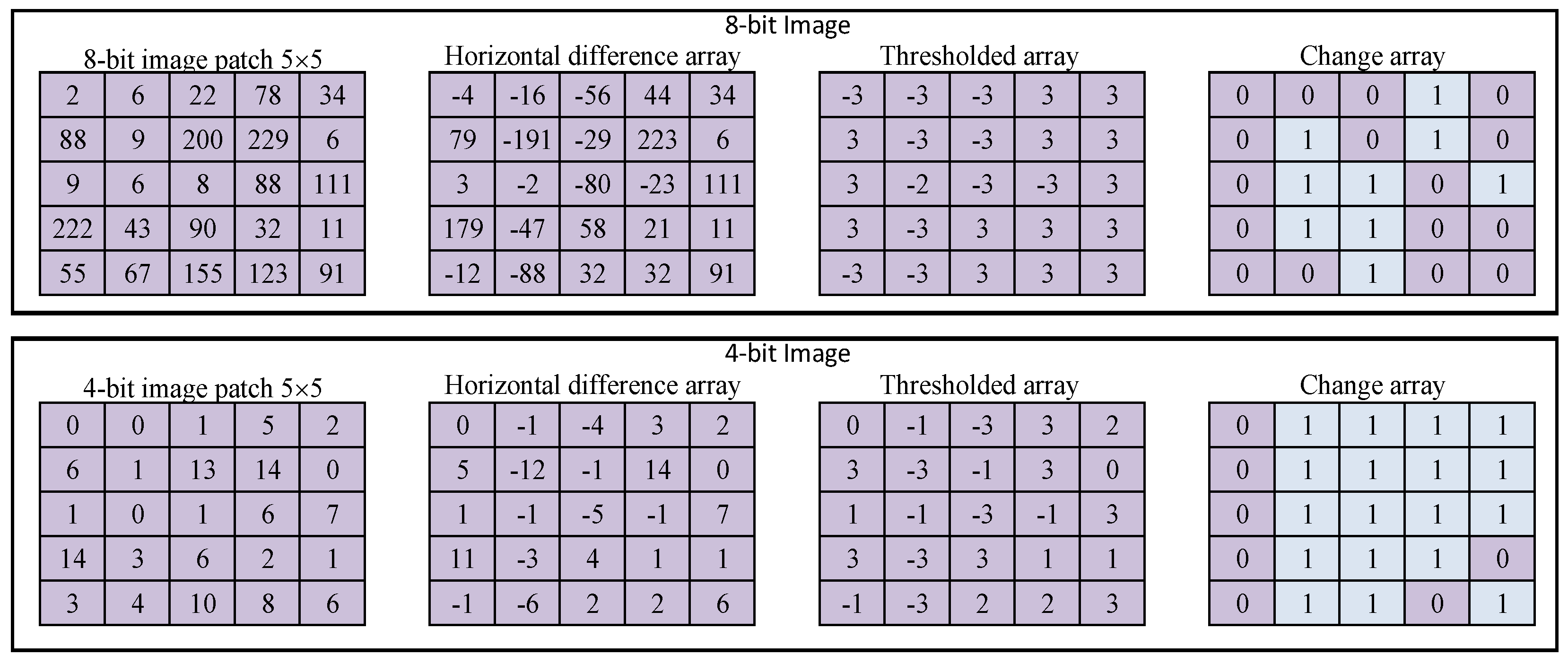
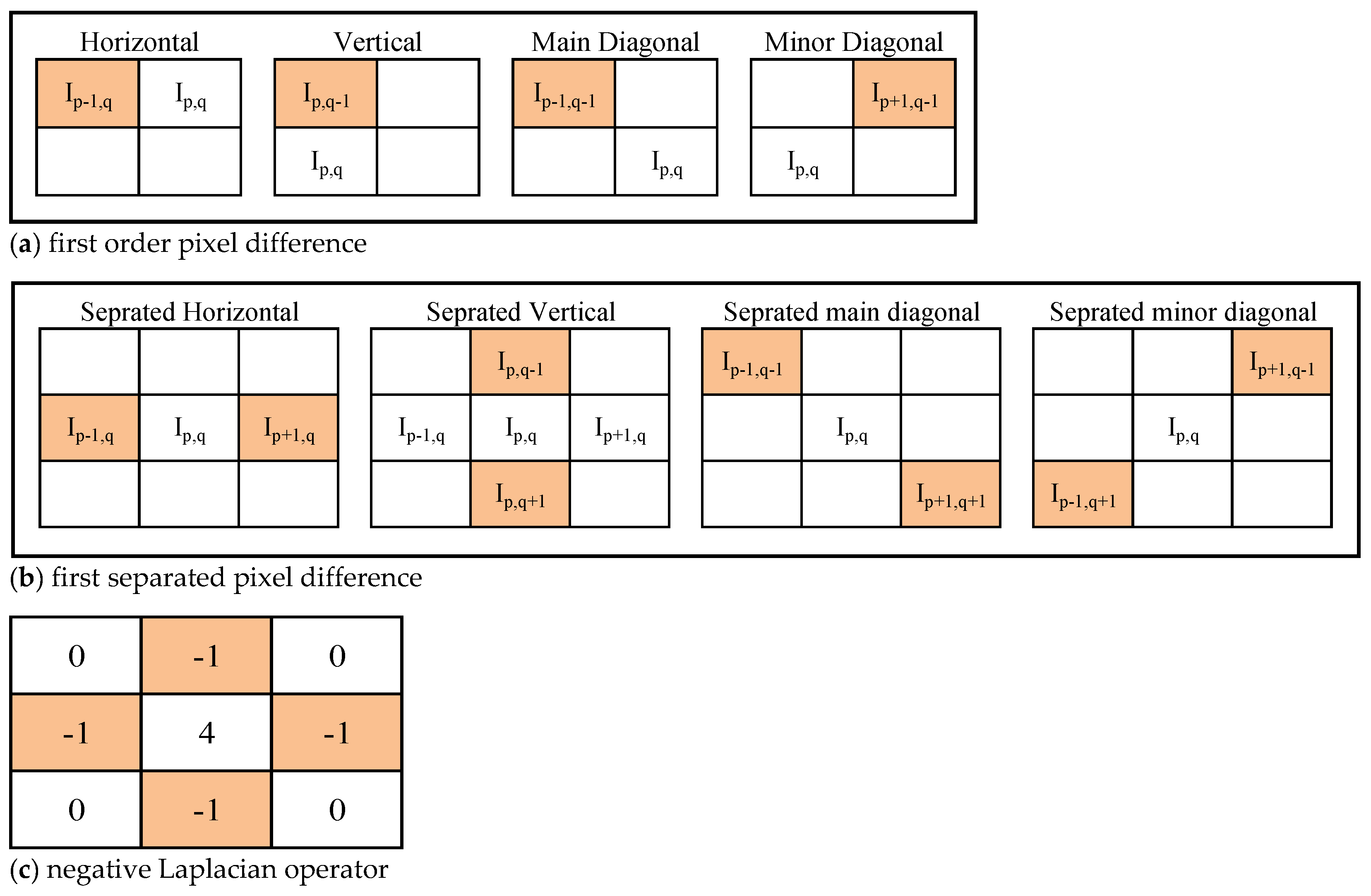
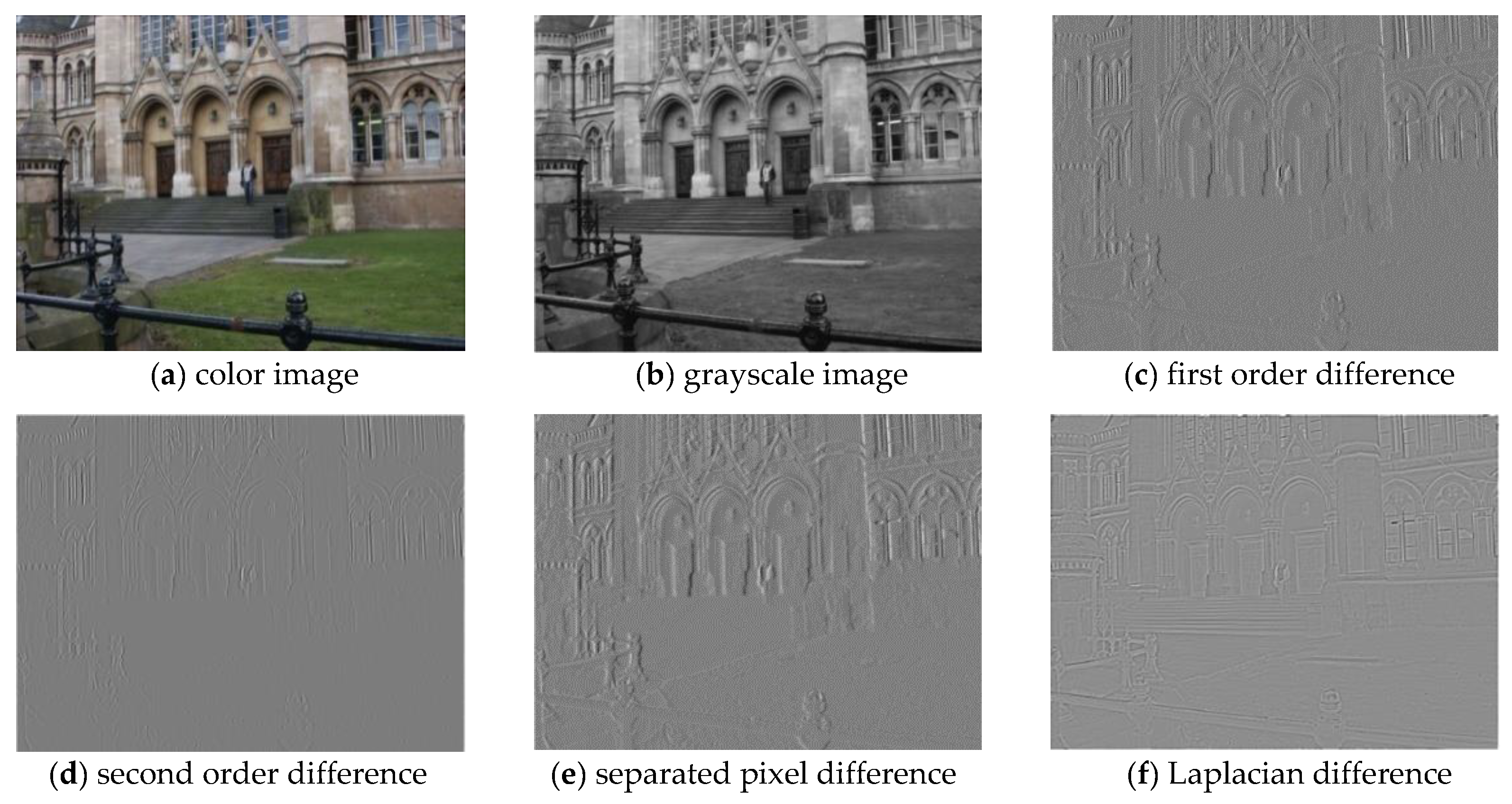
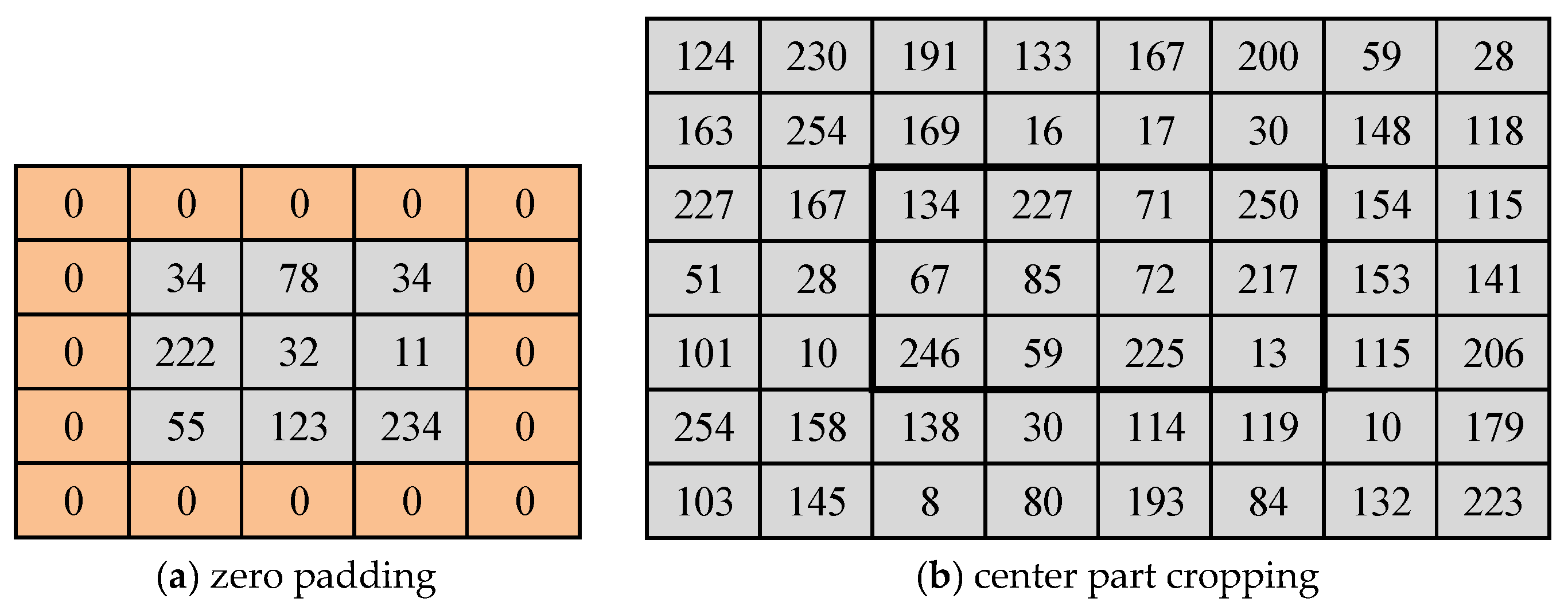

Publisher’s Note: MDPI stays neutral with regard to jurisdictional claims in published maps and institutional affiliations. |
© 2021 by the authors. Licensee MDPI, Basel, Switzerland. This article is an open access article distributed under the terms and conditions of the Creative Commons Attribution (CC BY) license (https://creativecommons.org/licenses/by/4.0/).
Share and Cite
Agarwal, S.; Jung, K.-H. HSB-SPAM: An Efficient Image Filtering Detection Technique. Appl. Sci. 2021, 11, 3749. https://doi.org/10.3390/app11093749
Agarwal S, Jung K-H. HSB-SPAM: An Efficient Image Filtering Detection Technique. Applied Sciences. 2021; 11(9):3749. https://doi.org/10.3390/app11093749
Chicago/Turabian StyleAgarwal, Saurabh, and Ki-Hyun Jung. 2021. "HSB-SPAM: An Efficient Image Filtering Detection Technique" Applied Sciences 11, no. 9: 3749. https://doi.org/10.3390/app11093749
APA StyleAgarwal, S., & Jung, K.-H. (2021). HSB-SPAM: An Efficient Image Filtering Detection Technique. Applied Sciences, 11(9), 3749. https://doi.org/10.3390/app11093749






